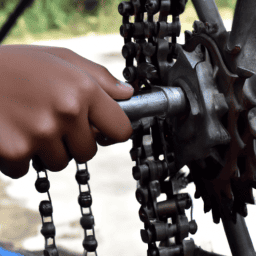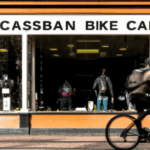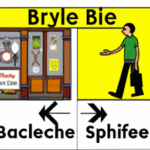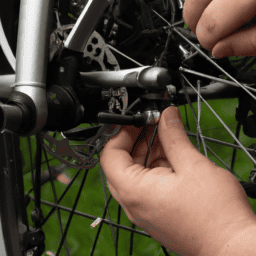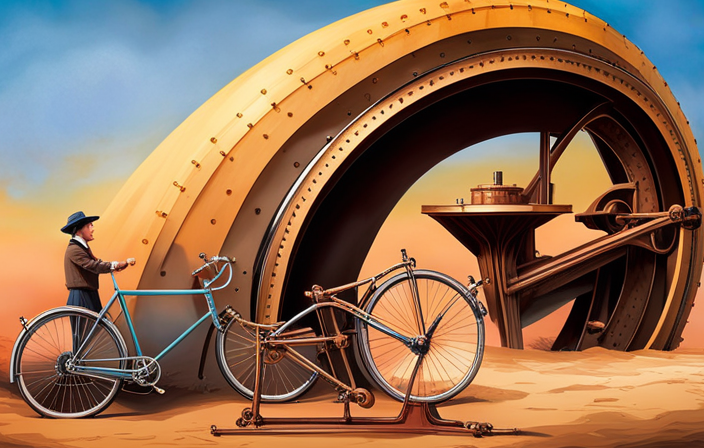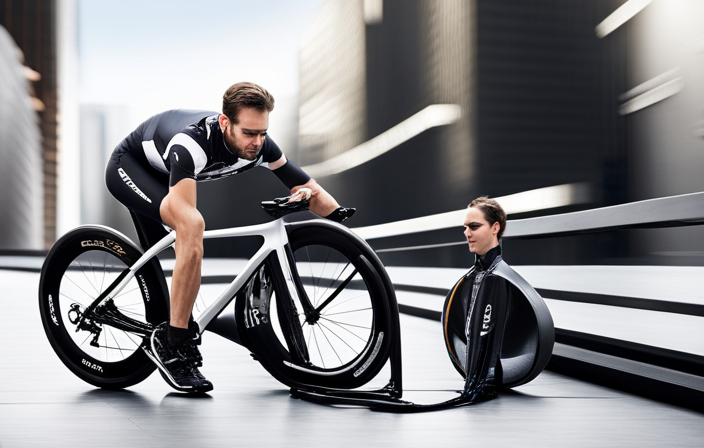Were you aware that by 2026, the worldwide bicycle industry is anticipated to hit a value of $62.39 billion? As an increasing number of individuals adopt cycling for transportation and fitness, the opportunity to sell your pre-owned bike has never been more opportune.
But where do you even begin? As someone who has sold multiple bikes over the years, I have learned a few tips and tricks that can help you navigate the process and get the most money for your beloved two-wheeler.
First and foremost, it’s important to consider your selling options. There are a variety of avenues you can take, each with their own pros and cons. Do you want to sell your bike locally through online marketplaces or social media? Or would you rather trade it in at a bike shop or sell it to a consignment store?
By understanding the different options available to you, you can make an informed decision that aligns with your goals and preferences. Let’s dive deeper into each step of the process to help you get started.
Key Takeaways
- There are different selling options available for selling a used bicycle, such as online marketplaces, bike shops, and consignment stores.
- Researching the market value of similar bikes in the area and assessing the bike’s condition are important factors in determining a fair price.
- Upgrades and accessories can increase the value of the bike, but it’s important to consider brand compatibility and the type of riding for appropriate upgrades.
- Negotiating with potential buyers requires transparency and honesty about the bike’s condition, setting boundaries, and knowing the bike’s worth while being open to reasonable offers. Proper follow-up etiquette and communication techniques can ensure a positive experience for both parties.
Consider Your Selling Options
Oh sure, you could always try to sell your bike to a museum, but considering your options, maybe try Craigslist or Facebook Marketplace first. These online platforms are great for reaching a large audience of potential buyers in your local area. Plus, they’re free to use!
All you need to do is create an account, take some good pictures of your bike, and write a description that’s both accurate and enticing.
Another option to consider is selling your bike to a local bike shop. While they may not offer the same price as a private buyer, they can provide a hassle-free and quick transaction process. Plus, they may even offer to buy your bike even if it needs some repairs or maintenance. Just make sure to do some research beforehand and compare the prices offered by different bike shops in your area.
Once you’ve decided on your selling option, it’s important to determine a fair price for your bike.
Determine a Fair Price
When determining a fair price for my bicycle, I always start by researching the market value of similar bikes in my area.
From there, I assess the condition of my own bike, taking into account any wear and tear it may have.
I also consider any accessories or upgrades that may add value to the bike.
By taking these factors into account, I can set a fair price that reflects both the bike’s value and its condition.
Research Market Value
To get a sense of how much my bicycle is worth, I’ll check out online marketplaces and see what similar models are going for. Researching the market value is an important part of determining a fair price for any item. There are several research methods that can be used to determine the market value of a bicycle. One popular method is to check out online marketplaces such as eBay, Craigslist, and Facebook Marketplace. These sites provide a wealth of information about what similar bicycles are selling for in your area.
To make the research process more efficient, I recommend creating a table to keep track of the information you find. Here’s an example of what the table might look like:
| Model | Year | Condition | Asking Price |
|---|---|---|---|
| Trek | 2015 | Good | $500 |
| Specialized | 2017 | Like New | $700 |
| Giant | 2016 | Fair | $250 |
By looking at the table, you can see what models are popular and what price range they fall into. This information can help you determine a pricing strategy that will make your bicycle competitive in the market. Once you’ve researched the market value, the next step is to assess the condition of your bike.
Assess the Condition of Your Bike
Before determining a fair price for your bike, you should carefully assess its condition to ensure that you’re accurately representing its value.
Start by checking the frame for any cracks or dents. These can significantly lower the value of your bike and, in some cases, make it unsafe to ride.
Additionally, inspect the wheels and tires for any signs of significant wear or damage. If the wheels appear wobbly or the tires are worn down, it may be time to replace them.
Next, evaluate the wear and tear on the bike’s drivetrain. Check the condition of the chain, cassette, and chainrings. If these components are significantly worn, they may need to be replaced to ensure the bike functions properly.
Finally, consider any cosmetic damage to the bike, such as scratches or chips in the paint. While these may not affect the bike’s functionality, they can impact its resale value.
By assessing the condition of your bike, you can determine a fair asking price and ensure that potential buyers have an accurate understanding of its value.
When considering accessories and upgrades, it’s essential to factor in their value when determining the overall price of your bike. Upgraded components, such as a new saddle or handlebars, can significantly increase the bike’s value. Additionally, accessories like a bike lock or lights can make the bike more appealing to potential buyers. Be sure to mention any upgrades or accessories in your listing to help set your bike apart from others on the market.
Consider Accessories and Upgrades
As I’m thinking about enhancing my ride, I keep in mind that adding accessories and upgrades can increase its appeal and overall value.
Before making any purchases, it’s important to consider customization options and brand compatibility. Here are four things to keep in mind:
-
Determine what type of riding you’ll be doing – Do you need a new saddle for comfort on long rides? Or maybe a new set of tires for off-road adventures?
-
Look for accessories that fit your bike’s brand – Different brands have different specifications, so make sure any upgrades you purchase are compatible with your bike.
-
Consider adding a bike computer – This can track your speed, distance, and even heart rate for a more comprehensive workout experience.
-
Don’t forget about safety – Upgrades like lights and reflective gear can make your bike safer and more visible on the road.
As I prepare my bike for sale, these upgrades and accessories can make it more appealing to potential buyers. Adding value to my bike can also help me get a higher price for it.
Prepare Your Bike for Sale
Get your bike looking its best for sale by cleaning it thoroughly and making any necessary repairs. Cleanliness maintenance is crucial to making a good impression on potential buyers. Start by removing any dirt or grime from the frame, wheels, and components using a soft-bristled brush and a gentle cleaner. Pay attention to the chain, gears, and brakes, as these areas are prone to collecting dirt and debris. A clean bike not only looks more attractive, but it also demonstrates that you have taken good care of your bike and value its longevity.
In addition to cleaning, make sure to do any necessary repair work before putting your bike up for sale. Check the tires for wear and replace them if needed. Inspect the brakes, gears, and chain for any signs of damage or wear and tear. Replace any parts that are not functioning properly. By taking the time to properly prepare your bike for sale, you will not only increase its value, but you will also make the transaction smoother for both you and the buyer. Now that your bike is looking and functioning its best, it’s time to handle logistics and communication.
Handle Logistics and Communication
When it comes to selling my bike, there are a few key points to consider in terms of logistics and communication.
First, I need to decide whether I’ll be shipping the bike to the buyer or meeting up with them in person.
Either way, I’ll need to negotiate with potential buyers and handle payment securely and efficiently.
By keeping these factors in mind and communicating clearly with potential buyers, I can ensure a smooth and successful sale of my bike.
Shipping and Meeting Up with Buyers
To ship your bicycle or meet up with a buyer, you’ll need to communicate with them to arrange the logistics. If you’re shipping internationally, you’ll need to ensure that you have all the necessary documentation and that you’re using a reputable shipping company. Make sure to also factor in the cost of shipping and any customs fees that may apply.
If you’re meeting up with a buyer, consider meeting halfway or in a public place for safety reasons. Be clear about the meeting location and time, and confirm the details with the buyer beforehand. If you’re shipping the bike, make sure to package it securely and provide tracking information to the buyer.
When negotiating with potential buyers, it’s important to keep in mind that they may have questions or concerns about the bike. Be open and honest about the condition of the bike and any repairs or maintenance that may be needed. By being transparent and accommodating, you’ll increase the likelihood of a successful sale.
Negotiating with Potential Buyers
Negotiating with potential buyers requires transparency and honesty about the bike’s condition and any necessary repairs to increase the likelihood of a successful transaction. Building trust is crucial to the process, as buyers want to know that they are getting a fair deal and that the seller is not withholding any important information. Setting boundaries is also important, as some buyers may try to haggle the price down to an unreasonable amount. It is important to know the bike’s worth and to stand firm on the price, while also being open to reasonable offers.
To aid in negotiations, it can be helpful to create a table of the bike’s features and any necessary repairs. This will provide potential buyers with a clear understanding of what they are getting and allow for more informed negotiations. The following table can be used as a guide:
| Feature | Description |
|---|---|
| Frame | Material, size, and condition |
| Wheels | Size, type, and condition |
| Gears | Number of gears and condition |
| Brakes | Type and condition |
| Seat | Type and condition |
| Repairs Needed | List of any necessary repairs |
By providing this information upfront, potential buyers can see the bike’s condition and any necessary repairs, which can help build trust and lead to a successful transaction. Once negotiations are complete, the next step is handling payment.
Handling Payment
After the negotiations have been finalized and the buyer and seller have come to an agreement, it’s time to figure out how the payment will be handled. When selling a bicycle, it’s important to consider the safety of the transaction and ensure that both parties are protected.
Here are three things to keep in mind when handling payment:
-
Consider setting up escrow: This is an option that can provide a secure way to handle payment for both the buyer and seller. An escrow service holds the funds until both parties have fulfilled their obligations, which can help prevent fraud and ensure that the transaction goes smoothly.
-
Accept multiple payment methods: Make sure you’re flexible with payment options. Some buyers may prefer to use a credit card or PayPal, while others may prefer a bank transfer or cash. By accepting multiple payment methods, you can increase your chances of closing the sale.
-
Communicate clearly: Once payment has been agreed upon, make sure to communicate the details clearly to the buyer. Let them know what payment methods you accept and any specific instructions for completing the payment.
When it comes to selling a bicycle, handling payment can be a critical step in the process. By setting up escrow, accepting multiple payment methods, and communicating clearly, you can ensure a safe and successful transaction. Now that payment has been handled, it’s time to close the sale and hand over the bicycle to its new owner.
Close the Sale
When closing a sale, my top priority is to finalize the transaction and ensure that everything is in order. This includes providing any necessary documentation, such as a bill of sale or transfer of ownership form.
Once the sale is complete, I always follow up with the buyer to ensure that they’re satisfied with their purchase and address any questions or concerns they may have. It’s important to maintain a positive and professional relationship with the buyer to ensure future business opportunities.
Finalize the Transaction
Once you’ve agreed on a price, you’ll need to exchange payment and the bicycle in order to finalize the transaction. It’s important to make sure you meet up safely with the buyer or seller, especially if you found them online.
Choose a public location with lots of people around, like a coffee shop or park. Make sure to bring a friend or family member with you for added safety. Before handing over the bicycle, verify the payment method and ensure that the payment has cleared.
Cash is typically the safest option, but if the buyer or seller insists on using an online payment platform, make sure to check that the funds are available and have been transferred to your account before giving them the bike. Once you’ve exchanged the payment and the bicycle, make sure to get a receipt or written confirmation of the transaction.
Remember to provide any necessary documentation, such as the original sales receipt or proof of ownership, to the buyer. This will help establish a clear chain of ownership and protect both parties in case of any future disputes. By following these steps, you can finalize the transaction with confidence and ensure a smooth and hassle-free sale.
Provide Any Necessary Documentation
Don’t forget to gather all the appropriate paperwork before selling your bicycle. This includes proof of ownership, such as the original receipt, bill of sale, or registration documents.
This will help to verify that you are the legal owner of the bike and prevent any disputes or legal issues from arising during the transaction. It’s important to have all the necessary documentation in place to ensure a smooth and worry-free transaction for both you and the buyer.
By providing proof of ownership, you can also give the buyer peace of mind knowing that they are purchasing a bike with a clear history. Once you have all the paperwork in order, you can move on to the next step: following up with the buyer.
Follow Up with the Buyer
After you’ve handed over the keys to your trusty two-wheeled steed, it’s a good idea to touch base with the buyer to ensure they’re enjoying their new ride. Following up with the buyer not only shows that you care about their satisfaction, but it also opens up the opportunity for future business and referrals. However, it’s important to exercise proper follow-up etiquette and communication techniques to ensure a positive experience for both parties.
To begin with, it’s essential to give the buyer some space and time to enjoy their bicycle before reaching out. A good rule of thumb is to wait at least a few days before making contact, as this time period allows the buyer to test out the bike and form their own opinions. When you do reach out, keep the tone friendly and professional, and ask open-ended questions that encourage the buyer to share their thoughts and feedback. Additionally, it’s important to listen actively and respond thoughtfully, as this shows that you value the buyer’s opinions and are willing to address any concerns they may have. By following these simple guidelines, you can ensure a positive follow-up experience that leaves the buyer feeling satisfied and valued.
| Communication Techniques | Follow-Up Etiquette |
|---|---|
| Keep the tone friendly and professional | Give the buyer some space and time |
| Ask open-ended questions | Listen actively and respond thoughtfully |
| Encourage the buyer to share their thoughts and feedback | Show that you value the buyer’s opinions |
| Address any concerns the buyer may have | Ensure a positive follow-up experience |
Frequently Asked Questions
How can I safely transport my bicycle to the buyer’s location?
To ensure transportation safety, I recommend using a sturdy bike box or a padded bike bag. Remove pedals, handlebars, and wheels, and wrap them securely. Consider hiring a professional shipping service for added peace of mind.
Are there any legal requirements or documentation needed for selling a bicycle?
As a knowledgeable seller, I emphasize the importance of legal requirements and bicycle documentation when selling. It is essential to have the necessary paperwork to avoid any legal issues. Ensure you have a bill of sale and proof of ownership.
Should I consider selling my bicycle online or in-person, and what are the pros and cons of each option?
When deciding between online vs. in person selling, consider your target audience and the level of interaction you prefer. Online selling allows for wider reach, but in-person sales may offer better price negotiation tactics.
How do I handle negotiations with potential buyers, and what should I do if they want to haggle on the price?
When handling buyers, I approach negotiations like a game of chess. I anticipate their moves and have pricing strategies in place. If they want to haggle, I remain calm and offer a fair compromise. It’s all about finding a win-win solution.
Is it better to sell my bike as a whole or in parts, and how do I determine which option is best for me?
To determine the best selling strategy for my bike, I’ll conduct market analysis to see if there’s demand for parts or complete bikes. I’ll then decide based on potential profit and time investment.
Conclusion
Well, that’s all for now! I hope this article has been helpful in navigating the process of selling your bicycle. Remember, there are many options available to you, including online marketplaces and local bike shops.
By determining a fair price, preparing your bike for sale, and effectively communicating with potential buyers, you’ll be well on your way to closing a successful sale.
As a final thought, I wanted to share a statistic that highlights just how popular cycling has become in recent years. According to a report from PeopleForBikes, the number of people who rode a bike at least once in the past year grew by 9.6 million between 2011 and 2019. That’s an increase of almost 20%!
This trend is expected to continue as more people seek out alternative forms of transportation and ways to stay active. So, if you’re looking to sell your bike, you can feel confident knowing that there are plenty of interested buyers out there. Good luck!

